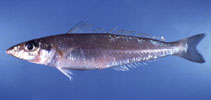| Family: |
Sillaginidae (Smelt-whitings) |
| Max. size: |
45 cm SL (male/unsexed) |
| Environment: |
demersal; brackish; marine; depth range 0 - 10 m, non-migratory |
| Distribution: |
Western Central Pacific: northern Australia, from Shark Bay, Western Australia to Moreton Bay, Queensland. Also known from the southern coast of New Guinea. Sillago nierstraszi is almost certainly a synonym of this species. |
| Diagnosis: |
Dorsal spines (total): 12-12; Dorsal soft rays (total): 16-18; Anal spines: 2-2; Anal soft rays: 14-17; Vertebrae: 33-34. The shape of the swim bladder is not distinguishable from that of S. ciliata. The anterior part of the swim bladder has rudimentary tubules projecting anteriorly and a lateral series, that diminishes in size and becoming sawtooth-like, projecting posteriorly. Body is light silvery, slightly darker to dusky dorsally. A dull golden silver to golden yellow stripe is below the lateral line. The pelvic and anal fins are pale yellow to bright yellow; the pectoral fin has a darker dusting of fine black-brown spots. |
| Biology: |
Juveniles of this species, together with those of S. schomburgkii remain in warm waters of the shallow mangrove creek shorelines and protected inlets. Mature S. analis prefer the muddy, tidal streams. The preferred prey are crustaceans. They also rummage in the silty-sand substrates for worms and have been observed to 'plough' up the bottom with the snout (Ref. 6205). Oviparous (Ref. 205). |
| IUCN Red List Status: |
Not Evaluated (N.E.) Ref. (130435)
|
| Threat to humans: |
harmless |
| Country info: |
|
Source and more info: www.fishbase.org. For personal, classroom, and other internal use only. Not for publication.

